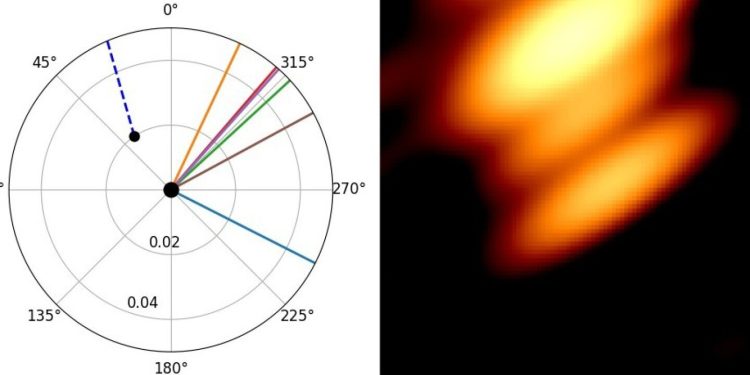
Two black holes orbiting each other in the quasar OJ287. On the left is a theoretical diagram, calculated by Lankeswar Dey, showing where the black holes and the jets emanating from them were at the time the photo was taken. On the right, part of an image taken by the system including the RadioAstron satellite (JL Gomez et al., 2022), where the two lower bright points are the radio emission coming from the two black holes, and the uppermost point is the jet from the smaller black hole. This is represented by a dotted line on the left diagram, while black holes are represented by dots. Credit: arXiv (2025). DOI: 10.48550/arxiv.2510.06744
For the first time, astronomers have managed to capture a radio image showing two black holes orbiting each other. The observation confirmed the existence of pairs of black holes. In the past, astronomers have only successfully imaged individual black holes.
An international team of researchers has successfully imaged two black holes orbiting each other at the center of a quasar called OJ287. Quasars are extremely bright galactic nuclei, whose light is produced when a supermassive black hole at the center of the galaxy devours the cosmic gas and dust surrounding it.
In the past, astronomers have successfully imaged the black hole at the center of the Milky Way and in a nearby galaxy called Messier 87.
“The quasar OJ287 is so bright that it can be detected even by amateur astronomers equipped with private telescopes. The peculiarity of OJ287 is that it is believed to host not one but two black holes rotating around each other in a 12-year orbit, which produces an easily recognizable pattern of light variations over the same period,” explains the first author of the research article, Mauri Valtonen, of the University of Turku, Finland. The work is published in The Astrophysics Journal.
Quasar discovered “by accident” in the 19th century
Early observations of OJ287 can be traced through old photographs to the 19th century, when the region of the sky in question was first photographed by astronomers. But at the time, it was inconceivable that black holes could exist, much less quasars. OJ287 was “accidentally” included in the images while astronomers were focusing on other objects.
Aimo Sillanpää, who was then a master’s student at the University of Turku, noticed as early as 1982 that the brightness of the object changed regularly over a period of 12 years. He later studied OJ287 as an academic researcher, assuming that the variation in brightness was caused by two black holes orbiting each other. Hundreds of astronomers have been monitoring the quasar intensively to see if the theory is correct and to get a complete picture of the black holes’ orbital motion.
The orbit mystery was finally solved four years ago by doctoral student Lankeswar Dey from Mumbai, India, working part-time at the University of Turku. The only question remaining was whether both black holes could be detected at the same time.
NASA’s TESS satellite answered this question by detecting light from two black holes. However, they were still only visible as a single point, because images using normal light do not have high enough resolution to show the black holes separately. An image was needed with a resolution 100,000 times higher, which is possible with radio telescopes.

Illustration of the proposed astrophysical system of OJ287. Credit: arXiv (2025). DOI: 10.48550/arxiv.2510.06744
Scientists have identified a new ‘wagging tail’ jet coming from the smallest black hole
In this latest study, astronomers compared previous theoretical calculations with a radio image. The two black holes were there in the image, exactly where they were expected. This allowed researchers to answer a question that had remained open for 40 years: the existence of pairs of black holes.
“For the first time, we managed to obtain an image of two black holes rotating around each other. In the image, the black holes are identified by the intense particle jets they emit. The black holes themselves are perfectly black, but they can be detected by these particle jets or by the glowing gas surrounding the hole,” explains Valtonen.
Researchers have also identified a completely new type of jet emanating from a black hole. The jet coming out of the smaller black hole is twisted like the jet from a rotating garden hose. This is because the smaller black hole is moving rapidly around OJ287’s main black hole and its jet is being diverted based on its current motion.
The researchers liken it to “a wagging tail” that is expected to twist in different directions in the coming years as the smaller black hole changes speed and direction of motion.
“The image of the two black holes was captured with a radio telescope system including the RadioAstron satellite. It was operational ten years ago, when OJ287 was photographed. The satellite’s radio antenna pointed toward half of the Moon, which greatly improved the resolution of the image. In recent years, we have only been able to use terrestrial telescopes, where the resolution of the image is not as good,” says Valtonen.
More information:
Mauri J. Valtonen et al, Identification of the secondary jet in the RadioAstron image of OJ 287, The Astrophysics Journal (2025). DOI: 10.3847/1538-4357/ae057e
Provided by the University of Turku
Quote: Image of two black holes circling around each other captured for the first time (October 9, 2025) retrieved October 9, 2025 from https://phys.org/news/2025-10-image-black-holes-circling-captured.html
This document is subject to copyright. Except for fair use for private study or research purposes, no part may be reproduced without written permission. The content is provided for informational purposes only.









